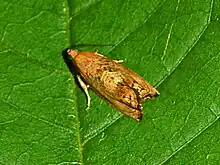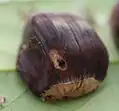Cydia amplana
Cydia amplana, the rusty oak moth, is a moth of the family Tortricidae. It is found from northern, central and southern Europe to Asia Minor, south-western Russia and Transcaucasus.[1]
| Rusty oak moth | |
|---|---|
 | |
| Scientific classification | |
| Domain: | Eukaryota |
| Kingdom: | Animalia |
| Phylum: | Arthropoda |
| Class: | Insecta |
| Order: | Lepidoptera |
| Family: | Tortricidae |
| Genus: | Cydia |
| Species: | C. amplana |
| Binomial name | |
| Cydia amplana (Hübner, [1799]) | |
| Synonyms | |
| |
The wingspan is 16–20 mm. The forewings have a large, lighter dorsal spot and darker slashes at the tip. Adults are on wing in June and July.
The larva is red, unlike the related species Cydia splendana, which has a white larva. They bore into the seeds of hazel (Corylus species), walnut (Juglans species), chestnut (Castanea species), beech (Fagus species) and oak (Quercus species). The larvae usually only feed inside nuts that have fallen to the ground, but at times the larvae cause significant damage by causing the nuts to drop.[2] It often needs two years for development.[3]

 Larval exit hole in sweet chestnut
Larval exit hole in sweet chestnut_Cydia_amplana_(14667322468).jpg.webp)
References
- "Cydia amplana". gdoremi.altervista.org. Retrieved 2021-12-16.
- , Drekić, M. and V. Vasić. 2012.
- Ellis, W N. "Cydia amplana (Hübner, 1800) vagrant piercer, rusty oak moth". Plant Parasites of Europe. Retrieved 31 August 2023.